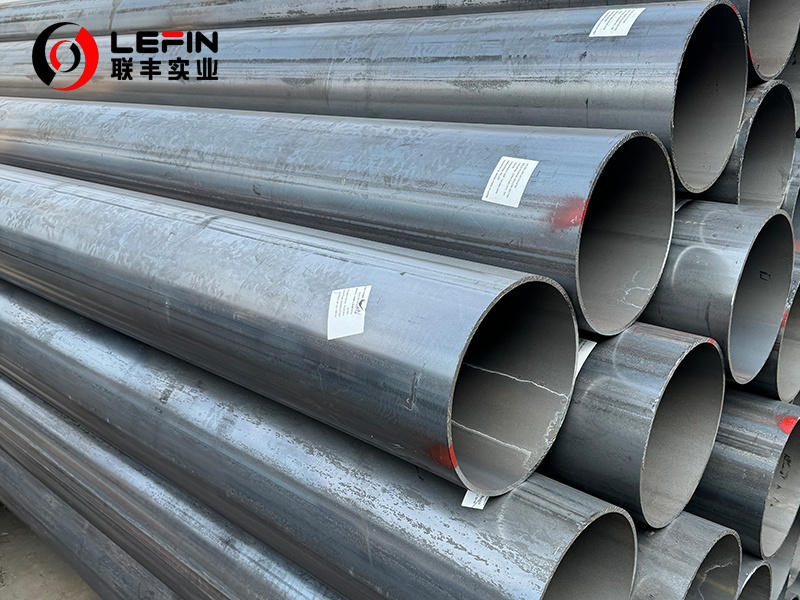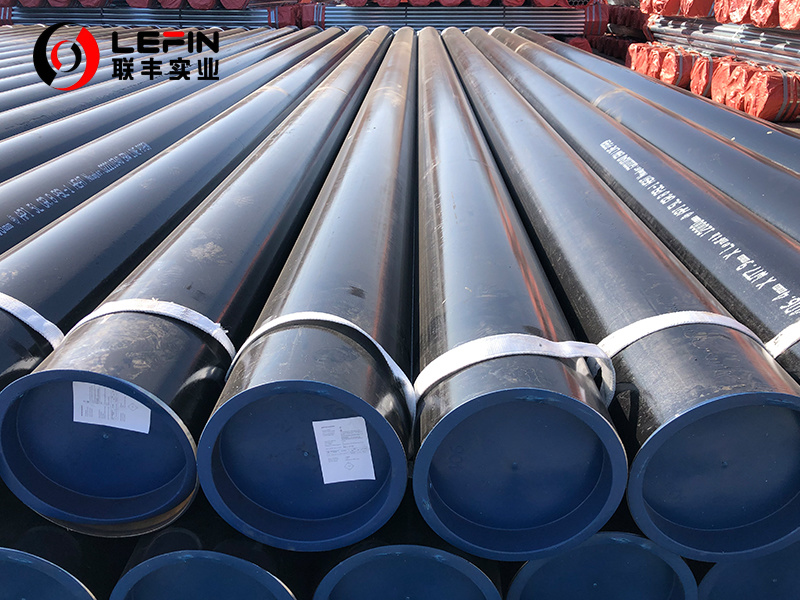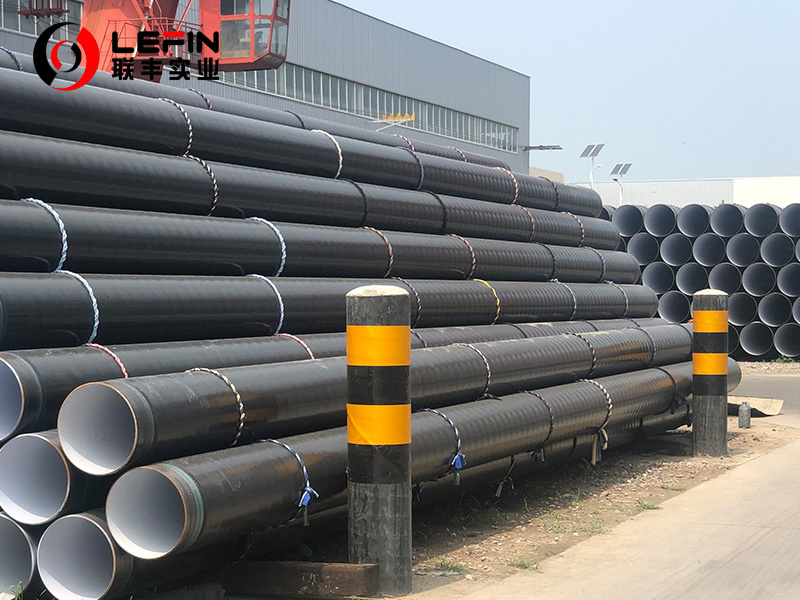





- Details
-
Basic Informaiton
ASTM A53 ERW (Electric Resistance Welded) steel pipe is a widely used welded steel pipe for general purposes, including construction, structural and transportation pipes.
- Production Process: ASTM A53 ERW steel pipe production process includes unwinding, straightening, end cutting, end shear welding, super coil accumulation, edge cutting, ultrasonic inspection, molding, induction welding, ultrasonic inspection of welds, medium frequency heat treatment, air cooling, water cooling, sizing, fly cutting, washing, cutting, flattening test, straightening, end machining and chamfering, hydraulic testing, ultrasonic inspection of welds, Pipe end ultrasonic inspection, visual and dimensional inspection, weighing and measuring, marking, coating, pipe end protection, bending and transportation steps.
- Specification: 1/2inch-16inch, wall thickness: 1.5mm--16mm
- Surface Treatment: Galvanizing, Black vanish, Carving, threading, Slightly oil painting, PVC clothes cover each bundle ect.
- Quality Control And Testing: ASTM A53 ERW steel pipe requires rigorous quality control and testing during the production process, including chemical analysis, mechanical testing, non-destructive testing (NDT) and hydraulic testing. Non-destructive testing is used to detect surface and internal defects, and hydraulic testing is used to check the leakage of pipes under pressure.
- Standard And Material Selection: ASTM A53 is a standard for welded and seamless steel pipes, widely used in construction, structural and transportation pipelines. ERW steel pipes are typically made of hot-rolled or cold-rolled steel and are suitable for a variety of environmental conditions, including high temperature, high pressure, low temperature, corrosive media and vibration environments.
- Application Field: ASTM A53 ERW steel pipe is used in a wide range of industries, including water and gas transportation, building structures, oil and gas transportation, and HVAC systems, due to its cost effectiveness and versatility.
- Advantages and Limitations:The benefits of ASTM A53 steel pipe include cost effectiveness, wide availability and versatility for a wide range of applications. Limitations include low strength compared to some other standards and limited corrosion resistance in highly corrosive environments.
- Ordering Information: When ordering ASTM A53 steel pipe, you need to provide precise ordering information, including grade, size, length and end treatment type.


Chemical composition
Electric Resistance Welding
GRADE
C
Mn
P
S
Cu
Ni
Cr
Mo
V
GR.A
0.25
0.95
0.05
0.045
0.4
0.4
0.4
0.15
0.08
GR.B
0.30
1.20
0.05
0.045
0.4
0.4
0.4
0.15
0.08
Physical property
Electric Resistance Welding
Grade
GR.A
GR.B
Tensile strength
330
415
Yield strength
205
240
Common Problem
1.What is the manufacturing process of ASTM A53 ERW (Electric Resistance Welded) Steel Pipe?
- Raw material selection: Select steel coil or steel plate with qualified quality as the starting material.
- Unwinding and straightening: unwinding and straightening the material for processing.
- End cut: Cut the material to the desired length.
- Edge milling: Milling edges to obtain accurate geometry.
- Molding: Shape the plate strip into a circle.
- Welding: Through high-frequency resistance welding to form a strong joint.
- Cooling: Pipe cooling and sizing.
- Sizing: Reduce the diameter of the pipe to the required size through a series of rolls or drawing reducing machines.
- Cutting: Cutting the ERW pipe to the specified length, the precision of this step is crucial because it determines the usability of the final product.
- Testing and inspection: Conduct rigorous testing and inspection to ensure that the pipeline meets industry standards and specifications. Common non-destructive testing methods include ultrasonic or eddy current testing to detect any defects in the weld or pipe structure.

2.How is non-destructive testing performed?
Non-destructive testing (NDT) is used to detect surface and internal defects such as cracks, breaks, corrosion and bubbles in steel pipes. The following are several common non-destructive testing methods and how they are implemented:
- Ultrasonic inspection (UT) : Signals are transmitted by using ultrasonic probes on the outside of the steel pipe and reflected signals are received inside the steel pipe. The position, shape and size of the defect are determined by analyzing the signal and image processing.
- Magnetic Particle Inspection (MT) : Suitable for detecting surface and near-surface defects in pipelines. First, the surface of the steel pipe is magnetized, and then magnetic powder is applied to determine the location and shape of the defect by lines or spots.
- Eddy Current testing (ECT) : Suitable for steel tubes of all shapes and sizes. The surface and near-surface defects of steel pipes are detected by the principle of induced eddy current.
- Radiographic inspection (RT) : Used to detect internal and deeper defects. It is detected by transmission or scattering of X-rays and image analysis.
- Infrared thermal imaging (IRT) : Suitable for detecting abnormal surface temperatures and hard-to-reach areas. Detection and evaluation through thermal energy, thermal image capture and analysis of infrared radiation.



ASTM A53 ERW STEEL PIPE
Subcategory
Keyword
- Details
-
Basic Informaiton
ASTM A53 ERW (Electric Resistance Welded) steel pipe is a widely used welded steel pipe for general purposes, including construction, structural and transportation pipes.
- Production Process: ASTM A53 ERW steel pipe production process includes unwinding, straightening, end cutting, end shear welding, super coil accumulation, edge cutting, ultrasonic inspection, molding, induction welding, ultrasonic inspection of welds, medium frequency heat treatment, air cooling, water cooling, sizing, fly cutting, washing, cutting, flattening test, straightening, end machining and chamfering, hydraulic testing, ultrasonic inspection of welds, Pipe end ultrasonic inspection, visual and dimensional inspection, weighing and measuring, marking, coating, pipe end protection, bending and transportation steps.
- Specification: 1/2inch-16inch, wall thickness: 1.5mm--16mm
- Surface Treatment: Galvanizing, Black vanish, Carving, threading, Slightly oil painting, PVC clothes cover each bundle ect.
- Quality Control And Testing: ASTM A53 ERW steel pipe requires rigorous quality control and testing during the production process, including chemical analysis, mechanical testing, non-destructive testing (NDT) and hydraulic testing. Non-destructive testing is used to detect surface and internal defects, and hydraulic testing is used to check the leakage of pipes under pressure.
- Standard And Material Selection: ASTM A53 is a standard for welded and seamless steel pipes, widely used in construction, structural and transportation pipelines. ERW steel pipes are typically made of hot-rolled or cold-rolled steel and are suitable for a variety of environmental conditions, including high temperature, high pressure, low temperature, corrosive media and vibration environments.
- Application Field: ASTM A53 ERW steel pipe is used in a wide range of industries, including water and gas transportation, building structures, oil and gas transportation, and HVAC systems, due to its cost effectiveness and versatility.
- Advantages and Limitations:The benefits of ASTM A53 steel pipe include cost effectiveness, wide availability and versatility for a wide range of applications. Limitations include low strength compared to some other standards and limited corrosion resistance in highly corrosive environments.
- Ordering Information: When ordering ASTM A53 steel pipe, you need to provide precise ordering information, including grade, size, length and end treatment type.


Chemical composition
Electric Resistance Welding
GRADE
C
Mn
P
S
Cu
Ni
Cr
Mo
V
GR.A
0.25
0.95
0.05
0.045
0.4
0.4
0.4
0.15
0.08
GR.B
0.30
1.20
0.05
0.045
0.4
0.4
0.4
0.15
0.08
Physical property
Electric Resistance Welding
Grade
GR.A
GR.B
Tensile strength
330
415
Yield strength
205
240
Common Problem
1.What is the manufacturing process of ASTM A53 ERW (Electric Resistance Welded) Steel Pipe?
- Raw material selection: Select steel coil or steel plate with qualified quality as the starting material.
- Unwinding and straightening: unwinding and straightening the material for processing.
- End cut: Cut the material to the desired length.
- Edge milling: Milling edges to obtain accurate geometry.
- Molding: Shape the plate strip into a circle.
- Welding: Through high-frequency resistance welding to form a strong joint.
- Cooling: Pipe cooling and sizing.
- Sizing: Reduce the diameter of the pipe to the required size through a series of rolls or drawing reducing machines.
- Cutting: Cutting the ERW pipe to the specified length, the precision of this step is crucial because it determines the usability of the final product.
- Testing and inspection: Conduct rigorous testing and inspection to ensure that the pipeline meets industry standards and specifications. Common non-destructive testing methods include ultrasonic or eddy current testing to detect any defects in the weld or pipe structure.

2.How is non-destructive testing performed?
Non-destructive testing (NDT) is used to detect surface and internal defects such as cracks, breaks, corrosion and bubbles in steel pipes. The following are several common non-destructive testing methods and how they are implemented:
- Ultrasonic inspection (UT) : Signals are transmitted by using ultrasonic probes on the outside of the steel pipe and reflected signals are received inside the steel pipe. The position, shape and size of the defect are determined by analyzing the signal and image processing.
- Magnetic Particle Inspection (MT) : Suitable for detecting surface and near-surface defects in pipelines. First, the surface of the steel pipe is magnetized, and then magnetic powder is applied to determine the location and shape of the defect by lines or spots.
- Eddy Current testing (ECT) : Suitable for steel tubes of all shapes and sizes. The surface and near-surface defects of steel pipes are detected by the principle of induced eddy current.
- Radiographic inspection (RT) : Used to detect internal and deeper defects. It is detected by transmission or scattering of X-rays and image analysis.
- Infrared thermal imaging (IRT) : Suitable for detecting abnormal surface temperatures and hard-to-reach areas. Detection and evaluation through thermal energy, thermal image capture and analysis of infrared radiation.



Related products
Product Consulting

Address: Hengtai Road,Daqiuzhuang Town,Jinghai County,Tianjin,China
Mob: +8615122229899(whatspp)
Phone: +86 22 58171905
Fax: +86 22 58171902
E-mail:info@lefinsteel.com
Get company updates

Tianjin Lefin Industrial Co.,Ltd. All rights reserved City sub-station SEO www.300.cn

